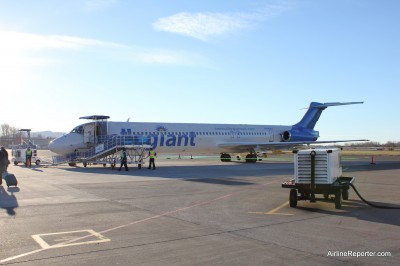
Allegiant MD-82 (N416NV) at Bellingham with a blue tail.
I recently had the opportunity to fly from Bellingham, WA to Las Vegas, NV on Allegiant Air (note: this was not a free ticket and I paid full fare). It was time for a little vacation, but vacation doesn’t mean I can’t review my flight.
On the blog, I have covered Allegiant quite a bit. I have looked at the possibility of them starting flights from Paine Field, talked about their Boeing 757’s and have explored their recent growth. However, I have never actually flown Allegiant and felt it was about time.
Although I haven’t flown them, I have had a small, odd crush on the airline. They have a very unique business model of flying older MD-80’s out of smaller airports and are geared towards the leisure traveler trying to get somewhere warm. They fly places that other low cost carriers don’t fly offering non-stop service to airports not usually served. They also seem to under cut the competition in fare price.
When booking my ticket I was looking at flights out of Seattle (SEA) and Bellingham (BLI – which is located about 1.5hours north of Seattle). Flying Allegiant out of BLI was $50.00 cheaper than anyone else — even after the fees I ended up paying. Add that parking at BLI is only $9/day vs $28/day at SEA and the 1.5hr drive north sounds like a good idea compared to the 30min drive south for me to SEA (ok, so when I have to drive it from 1am-2:30am when I got back, it didn’t seem so great at the time).
There is no hiding that Allegiant love their fees. If you are just flying with a carry-on. don’t care about where you sit and you don’t eat anything you can get to your destination for dirt cheap. Allegiant has become quite skilled at trying to sell you things during every step of the travel process from going onto their website to getting off the airplane.
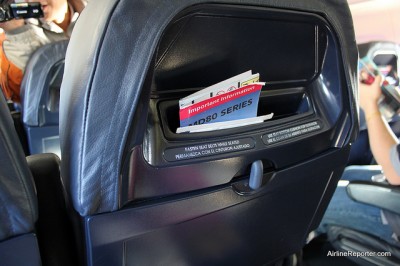
Allegiant's new seats have the seat pocket located on the top of the seat.
This is not to say I blame them for this, I have always said I do not mind fees. If I am traveling light why should I have to pay for people who are not? When booking my ticket these were some of the “upgrades” I was offered. Some of these fees you do not see on every airline (note that the priority boarding fee is the same for each flight, but the other seat fees will differ depending on flight length):
* Priority boarding: $9.99 – allows you to get on the plane first making sure you have overhead room.
* Premium seat selection: $9.99 – you get an assigned seat near the front or at the exit rows.
* Standard seat assignment: $6.99 – gives you an assigned seat towards the back of the aircraft.
* Online checked bag fee: $39.98 – might be more than the industry average, but you want to pay it online, since it will cost you $70.00 per bag at the airport.
You can fly without having to pay any of these fees, but many will end up paying. Allegiant recently went to a new boarding process. First the people that pay the $9.99 for the priority boarding get to board. Then those who need a little extra time (not kids or family) that they need extra time getting seated get to board. Next, passengers with seat assignments get to find their seats. Then those who do not have seat assignments, but have kids that are under 7. Then it goes to open seating and people get to pick what is left as far as seats and overhead bin space. On the flight to LAS, there weren’t many who went with open seating, but it seemed most of the plane was open seating on the way home.
Normally I wouldn’t pay for an assigned seat, but on this trip I was flying with my girlfriend Amy and I wanted to make sure we sat together. I didn’t get the premium seats and even after the $32.00 seating fees (for both of us there and back) our tickets were still $50.00 cheaper than the competition. Since Allegiant flies MD-80 aircraft, paying more to sit up front can be more useful since you are farther away from the jets in the rear of the plane.
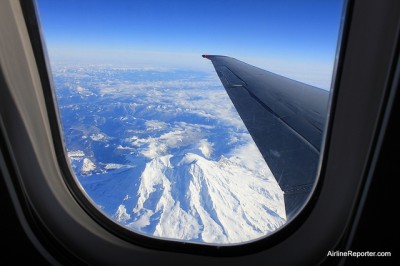
Got a nice view of Mount Rainier heading south towards Vegas.
One annoying aspect of Allegiant’s fees is most are opt-out fees. It automatically signs you up for the $9.99 priority boarding and seat assignment charges and asks if you are really sure you want to opt-out. After I thought I opted out for everything and I was on the payment screen and I had “additional charges” adding up to around $60.00 that I didn’t know what they were. It took me a while to realize Allegiant already added two tickets for a hotel shuttle and for travel insurance. I could see people not realizing what is going on and paying for them, even if they didn’t want or need them. Even though it was a bit more work to get the tickets (it was almost game like and I think I won) I still ended up with super cheap tickets.
Although their aircraft are a bit older, the ones I flew on (N416NV & N419NV) were quite clean. The new Allegiant seats are a bit unique with not having a standard seat pocket. Instead of the seat pocket being down by the knees, it is up above the tray table and is much smaller. This allows them to put the seats closer together and cut down on turnaround time since there really isn’t room to put trash.
The new seats are also “pre-reclined,” which is fancy airline-speak for they do not recline. For me, this is a non-issue. I rarely recline my seat out of respect for the people behind me. Non-recling seats allow more seats to be put in, cuts down on maintenance costs, which allows more revenue and keeps your ticket cost cheaper. For some reason, so many people do not see this connection. There are many other airlines out there that might provide a bit more room, less fees and a reclining seat, but it will cost you more to fly them.
Once you are on board the plane, you have more fees to consider paying as well. Unlike most other airlines, there is no free food or drinks. Not even that small glass of Diet Coke or a miniature bag of peanuts. A 12oz soda will cost you $2 and snacks range from $2-$6. Of course you also have the choice of beer for $5 or mixed drinks for $7. Considering I paid $3 for a soda and $5 for a bagel with cream cheese at the airport before boarding, I should have waited.
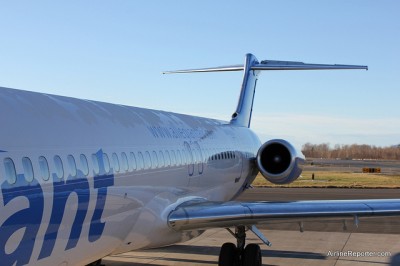
Boarding on the tarmac at Bellingham allows one to get views like this, which you can't get on a jetway.
The flight attendants also sell tickets to events and shuttle tickets while on board (at least on my Vegas flight). My biggest regrets of my flight was not getting an Allegiant MD-80 model – which they also sell. They won’t advertise them, so you have to ask for it. I totally forgot on the flight to LAS and was sleeping the entire way back to BLI.
One reason I slept the entire flight back was it was so late. The plane was scheduled to leave LAS at 8:05pm, but we didn’t take off until about 10:30pm. De-icing and flight plan issues caused the delay. Add to that sitting in the plane for about 1.5hrs of that delay with a loud kid in front of us and a group of college kids behind us, it was not fun. At least they did allow us to use our electronic devices and the restroom during the wait. Although it was annoying, what can you do? There are delays in any form of transportation. How many times am I sitting in Seattle traffic and it takes me an hour to go just ten miles (a lot btw)? As always people seem to get angry at the airline for delays; like someone is sitting in a room somewhere making a plane late for fun. The pilots, flight attendants, ground crews, airport personnel, operations managers and everyone else waiting on the last flight of the day do not want the delay anymore than you. These sorts of things happen in a complex business like this and I always find it is best to roll with the punches (although Amy can attest I was getting grumpy at the time).
Allegiant has a smart model that works and they will continue to grow their route map. They own their planes, fly to smaller airports, concentrate on leisure travelers, provide complete travel options and have fees. It obviously is working for them since they have been able to grow rapidly over the past few years and I have a feeling it will continue to work for them. How have your experiences with Allegiant been?
During my time in Vegas, I was also able to take a visit of Allegiant’s head quarters and will be sharing that with you soon. Stay tuned.
 Airbus versus Boeing. Who doesn’t love a good competition between the world’s two largest commercial airline manufactures? I try to say I am not slanted one way or another, but living 15 minutes away from where most Boeing aircraft are made might make me a bit biased. The saying around these parts, “If it isn’t Boeing, I am not going,” is pretty popular. I actually know a few people who honestly will not fly an Airbus or Boeing product just on principle. I don’t go that far.
Airbus versus Boeing. Who doesn’t love a good competition between the world’s two largest commercial airline manufactures? I try to say I am not slanted one way or another, but living 15 minutes away from where most Boeing aircraft are made might make me a bit biased. The saying around these parts, “If it isn’t Boeing, I am not going,” is pretty popular. I actually know a few people who honestly will not fly an Airbus or Boeing product just on principle. I don’t go that far.
Anyhow one of the constant “this manufacture is better,” arguments I hear is that the Airbus A320 seats are so much wider than the B0eing 737s. I figured it was time to find out. I took a look at airlines from around the world that fly both aircraft and used SeatGuru.com to find out the width of each seat.
I wanted to check the accuracy of the information SeatGuru has on their site, so I spoke with Jami Counter, Senior director of the site and he stated, “SeatGuru’s content team utilizes flyer comments to maintain the accuracy of our airplane seat information and updates the site with both user-submitted reviews and independent research.” That being said, I am by no means saying this is 100% scientific, but I think it can give a good comparison between the two.
Both the Airbus A320 and Boeing 737 families have the same width no matter what model they might be (ie a Boeing 737-200 is just as wide as a -900). Airbus starts out ahead with a fuselage width of 156″ and a cabin width of 146″. The Boeing 737 is a bit smaller with a 148″ fuselage and only 139″ in the cabin. This means that the Airbus A320 has 7 more inches of width than the Boeing 737. If an airline did things right, each seat and the aisle could have 1″ more width than the 737.
I took a look at airlines running the Boeing 737 and/or the Airbus A320. I compared both the standard economy seating and also premium seating (some airlines call it first class, business, etc). The economy is shown with an “E” and premium with a “P.” If an airline had multiple seat widths in the same category, I averaged them together. Here are my results in inches:

On average, the Airbus A320 seats are wider, but not by much. Only about 1/2″ in economy and almost no difference with premium seats. It seems that airlines and seat manufactures are not using that extra 7″ of cabin width that the Airbus A320 provides.
When I asked Counter from SeatGuru about his thoughts, he told me, “While the A320 does have a wider diameter fuselage, it doesn’t necessarily mean that airlines will put in a significantly wider seat.” He also took a look at the data they have on their site and came to a similar conclusion that the A320 will have slightly more width on average. “On SeatGuru we’ve found that while there is some variation, we generally see airlines give about 17-17.2″ seat width in coach on a B737, while they give about 17.5″-18″ seat width in coach on an A320. These differences depend on the types of seats airlines use, as well as the overall seating configuration of the aircraft. ”
Is it worth making an effort to fly on a Airbus A320 for more room? I am going to say no. I know that many people have a preference of aircraft type they fly on and I am assuming that fractions of an inch isn’t going to persuade a person one way or another. However, airline loyalist have always surprised me in the past. Does this information change your views on flying on either the Boeing 737 or Airbus A320?
Orig Image: Caribb
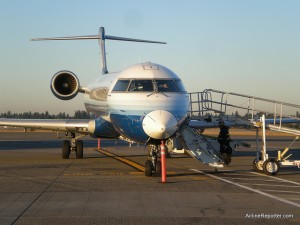
United Express CRJ-700 on the tarmac at Seattle
This flight was something special for me. My first CRJ-700 flight ever and my first United Express flight in quite some time. As I just discussed recently, even though my plane might have “United” on the side, the flight is actually operated by SkyWest under the “United Express” brand.
My flight left early…7am. That meant getting up before I think people should be awake and heading to the airport. At least it was a beautiful morning and I was able to capture a few shots of my CRJ-700 on the tarmac with the moon behind it. One of the gate agents was so taken with the moon she made an unusual announcement letting passengers know they should check out the moon and many passengers flocked to the window. It was kind of cool to see that level of interaction.
United recently started being more aggressive selling upgrades to customers. I didn’t get around to checking in at home, so I did so at the airport. I was asked if I wanted to pay an extra $29 for Economy Plus, which gives you a few inches of extra leg room, you sit at the front of the plane and you get to board earlier. I didn’t feel the need to pony up the $29.00 extra for the 2.5hr flight. Since the flight was overbooked, I had to get my seat assignment at the gate. Lucky for me I got seat 6D, which was Economy Plus and I didn’t have to pay. Due to the overbooking, United was offering $400 travel vouchers which went fast. Everyone who wanted to fly was able to fly.
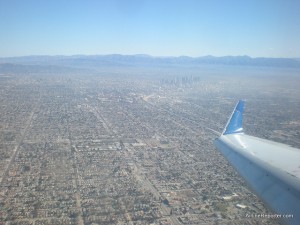
LA was pretty smog free on this flight...nice!
Before boarding a gate agent came on the intercom and apologized they had no jetway for the flight and we would have to board on the tarmac. Ha! No one should ever have to apologize for boarding on the tarmac. Okay, maybe the average passenger might not like going down the stairs or dealing with bad weather (United does provide umbrellas), but to me it is always worth it. Being down with the plane and boarding on the tarmac is always a welcomed experience.
The take off on the CRJ-700 was amazingly smooth. There wasn’t the big jolt you get with most other airliners. Many pilots I have talked to, see the CRJ-700 as a hotrod. Improved wings and engines over the CRJ-200 make the CRJ-700 a nimble and quick aircraft. It is able to take off quickly, while cruising at Mach 0.78.
Going to the rear of the aircraft was an interesting adventure. Unfortunately when I got up, the sign said no one was in the lavatory, but by the time I got there someone snuck in. Unlike larger aircraft there is no where to stand in the back of the CRJ-700. There is only the last row of seats and then, BAM the bathroom. So, when waiting you are standing in the aisle right next to seats with either your butt, crotch or thigh in their face. Akward for me and has to be annoying for the people in the back. When the passenger came out of the restroom, it was difficult to let them pass me without bumping into the passengers in the back row.
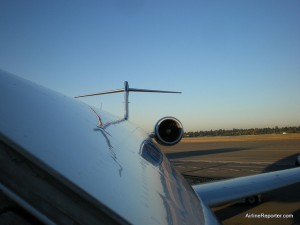
I love boarding on the tarmac!
The rear of the plane is also quite a bit louder. With the combination of the increased sound, not being able to recline your seats and people standing/walking past you to use the restroom, I suggest avoiding sitting in the back if you can. It would surely be worth the $29 to get Economy Plus versus having to sit in the back row.
The flight down to LAX was beautiful and clear, making the scenery a real treat. I only wish it was easier to see out my window in seat 6D. The CRJ-700 has windows pretty spaced out, as you find more with regional jets versus larger airliners. Some seats end up perfectly aligned and others, like 6D, end up in an odd position. On my flight back home I got seat 10D, which is not Economy Plus, but my window was perfect. Even at 6’1″, I would rather have a lined up window than extra leg room, but I know most passengers probably don’t feel the same way.
Even with the hindered view, having the extra leg room on the flight to LAX was nice. On both flights I worked on my laptop (actually writing up this blog) and it was much easier with the extra room (I have a gut that gets in my way, as well). Even with the person in front of me in Economy Plus reclined, I had no problems with my laptop being fully open, but it wasn’t the same in standard seating.
From my own personal experiences and reading those of others, I often have a lower expectation level for regional airlines. I was quite happy with the service, friendliness and professionalism from all four SkyWest flight attendants working the United Express flights.
Even though the plane might be a bit smaller and have a few draw backs (ie don’t sit in the back and go to the restroom before flying), the positives outweigh the negatives. Running smaller aircraft, like the CRJ-700, allows airlines to provide more daily flights and in more cases at a cheaper fare. Getting on and off the plane is much quicker than a larger Boeing 737 or Airbus A320 and if you are an airline nerd (which you might be reading this), you have a greater chance to board on the tarmac.
MORE PHOTOS
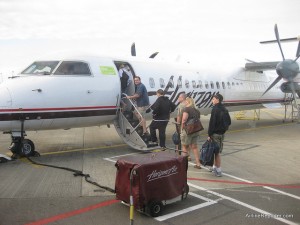
Me about to board the Q400 in Seattle. I should have waved, presidential-style.
I have flown the route from Seattle to Reno many times in my life. From Reno Air back in the day, to Southwest, to America West to Alaska Airlines. The flight is easy, only about 1.5hrs, enough time to take off, get a drink and snacks and start the descent. In April 2008 Horizon Air took over the route for Alaska and since then, they have been the cheapest to fly. I actually prefer the flight on Horizon’s Q400’s versus Alaska’s Boeing 737 (or MD-80’s back in the day).
The main reason is, I love flying in smaller planes. It really lets the passenger connect with the flying experience. I think a lot of people do not like flying on smaller planes just for this reason. Unlike the larger planes, you get to board on the tarmac, which allows you to see the entire plane, not just a few inches around the door when you board in a jetway. The inside of the Q400 is set up in a 2-2 layout, so you always get a window or aisle. Of course I always go for the window, but I am happy to know if I don’t get one, I won’t be stuck in the middle.
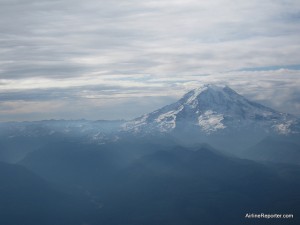
Mount Rainier, just outside of Seattle, was one of many mountains you can see on the Seattle to Reno flight.
On this trip I was in a group of four people, which allowed me to get a few photos of me with the plane and even better photos from both sides of the plane while flying. The flight from Seattle to Reno is beautiful. From Mount Rainier to Crater Lake, if it isn’t cloudy, you are in for a real treat. The Q400’s fly quite a bit lower at about 25,000 feet versus 30,000 to 40,000 with larger aircraft and their wings are high, which means everyone has an awesome view.
We all checked in the day before online and only had carry-ons, so we didn’t have to wait in any Horizon lines, just put up with the security ones. Horizon has a semi-hybrid option between carry-on and checking your bags, called Ala Cart. Since the overhead bins are smaller than you would find on larger aircraft, not all carry-ons can fit in them. If yours cannot fit or you don’t want to lug it on the plane you can put your carry-on on a cart while boarding. They will put it on another cart when you arrive at your destination. It’s way quicker than having to wait in baggage claim not to mention, the Ala Cart option is free. If you do need to check your bag, it will cost you $20 per bag, up to 3 bags. Like their sister carrier, Alaska Airlines, Horizon also provides the 20 minute checked baggage guarantee.
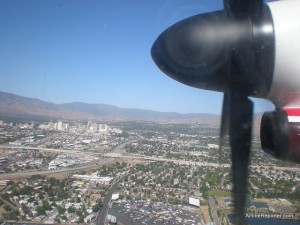
Beautiful downtown Reno, just about to land.
Talking about Alaska Airlines, Horizon’s relationship with them is quite unique. Some people think of Horizon as Alaska’s regional carrier, but they are set up very differently. Both airlines have a parent company, Alaska Air Group which owns and manages both airlines. Most regionals fly for a larger airlines for fees and Horizon will sometimes fly for Alaska, but they mostly fly under their own brand. Horizon has their own marketing department, their own ads and unique brand of service. You will see the two airlines share a website together, but both logos are prominently displayed.
One thing that does make Horizon unique is offering free, regional wines and micro-brews, ah yea…can’t miss out on this. Our flight left at 7:40am, but that didn’t stop us from trying out some of that free local wine and beer. I mean, come-on it was the blog right?! Horizon is also offering free snack-packs on their Seattle to Portland flight, but I have yet been able to experience that first hand.
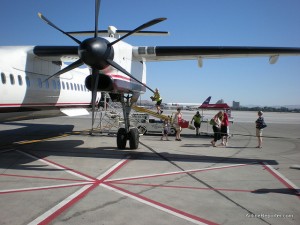
Passengers were able to de-board from the front and back of the Q400, making it super quick. Employees are getting the Ala Cart bags out.
A passenger in our group (we shall call her “Rita”) was a little apprehensive about flying on a smaller aircraft. I know many others out there have that same fear. However, I quickly pointed out that Horizon Air is extremely safe and has never had a fatality since they started flying in 1981 and haven’t had any sort of incident since 1990. That made Rita feel much more comfortable and after the flight she very much loved her Horizon experience (maybe the glass of wine she had at 8am helped too).
The Horizon Q400’s might be a bit slower than jet airliners, but they are much more cost effective and friendly for the environment. Horizon has green stickers on each of their planes touting how green they are and even painted one of their Q400’s entirely green (can you see “Shrek” as they call it here or here?)
I definitely get excited to fly on Horizon and flying on the Q400’s and hope that some of you can feel a bit more at ease flying in smaller planes in the future.
Check out my (ok our, thanks Ben, Rita and Amy) additional pictures of the trip.
UPDATE: I have been informed there are two green Q400’s, nicknamed “Shrek” and “Fiona.”
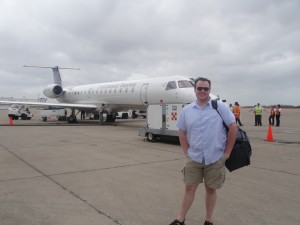
Me in front of the first ERJ-145 I flew after landing at Mazatlan Airport. I love being able to get close to the plane on the tarmac.
I am currently about 37,000 feet on a Continental Express ERJ-145. I am heading from Mazatlan, Mexico (MZT) to Houston, TX (IAH), then on to my home in Seattle (SEA) [which will be on a Boeing 757]. Well, sort of…right now, as I write this blog, it is the morning of Saturday May 8th. My flight does not have wi-fi, but I am writing it in notepad and will post it up on Monday the 10th. Every time I am in the air, I always try to write up at least a few blogs, since I love the inspiration.
This is my second flight in a regional jet, my first being a week ago heading from IAH to MZT. It is quite amazing, with all my flying experience I have not flown on a ERJ-145. My home base is in Seattle and there just aren’t many flights with regional jets to and from SEA.
When booking my flight, I purposely choose Continental since I would be able to fly on an ERJ-145 (I know, I have heard the “airline nerd” jokes already). I have heard some positive, but mostly negative things about flying the aircraft and I was excited to check it out myself.
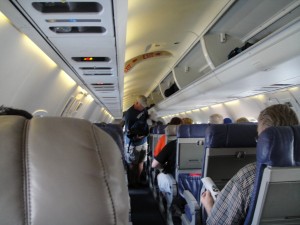
The 1-2 layout is nice, but small overhead-bins are only on one side.
There are a lot of people out there that do not like flying in smaller planes. They will go out of their way and pay more to avoid them. Yes, the ride can be more bumpy, there are normally less experienced pilots flying them, and it can be a tight fit. However, I think the positives out weigh the negatives.
For me, the smaller the aircraft let me feel more connected to the flying experience. I understand that some people like to forget they are in a man-made machine 37,000 feet above the ground, but not me.
I enjoy the 1-2 seat layout. There is a single seat on the left side of the plane and two seats on the right side of the plane. This means that every person either has a window or aisle seat. On both flights I sat on the single seat side. It is nice being able to see out the window and have easy access to the aisle.
The seats feel quite roomy and the ERJ-145 has 17.3″ width and 31″ pitch, which isn’t bad. The Boeing 737-800 I flew from SEA to IAH also had 31″ pitch and only 17.2″ width.
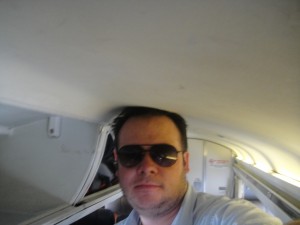
Don't make fun of my hecka-awesome shades or my man-beard. Headroom wasn't so great for being 6'1".
The ERJ-145 only holds 50 passengers, which gives it an intimate experience. I seems easier to talk to other passengers and get to know those around me. Since there are less passengers, the turn around time of the aircraft is very short (time from landing to being able to take off again). This allows airlines to provide more flight options to destinations and more flights to smaller airports.
There are a few downsides to the ERJ-145. I am currently sitting in row 17 of 19 rows. The only lavatory is located at the back of the aircraft. It seems not many people went to the restroom before taking off, since a lot of folks have made a visit back here. I could see where this would be distracting for someone wanting to sleep.
There is also very limited carry-on room. If you are trying to bring on bigger carry-ons, be prepared to have them checked. Out of the five of us travelling in my group, only two were able to bring their carry-ons aboard (and we were able to take all of them on board the Boeing 737 from SEA to IAH).
I have heard people talk about service on smaller regional aircraft can be sub-par. Even though I have experienced great service on some smaller airlines, like Horizon Air (the free beer or wine helps), I have personally seen a lower level of service when flying regional aircraft. Although I did get a free snack (this will be short lived), the flight attendants, both to and from MZT, definitely were not friendly and were quite rude to passengers. It could have just been a coincidence, but it was noticeable.
My flights to and from MZT were Continental Express, which is run by ExpressJet, however, the Continental name is on the airplane and on my ticket. I strongly feel that is a larger airline is willing to put their name on a regional airline, they are partly responsible for the quality of service one receives. Passengers should have a consistent level of service no matter what kind of aircraft they are flying.
The ERJ-145 is built by Embraer, an airplane manufacture based out of Brazil. The aircraft first flew in August 1995 and started service with airlines in 1996. To date over 1,100 ERJ’s have been manufactured. With so many ERJ-145’s out there and many more on order, I have a feeling this won’t be my last experience with this aircraft type.
Find a few more pics via my Flickr account.
connect | web | twitter | facebook |















